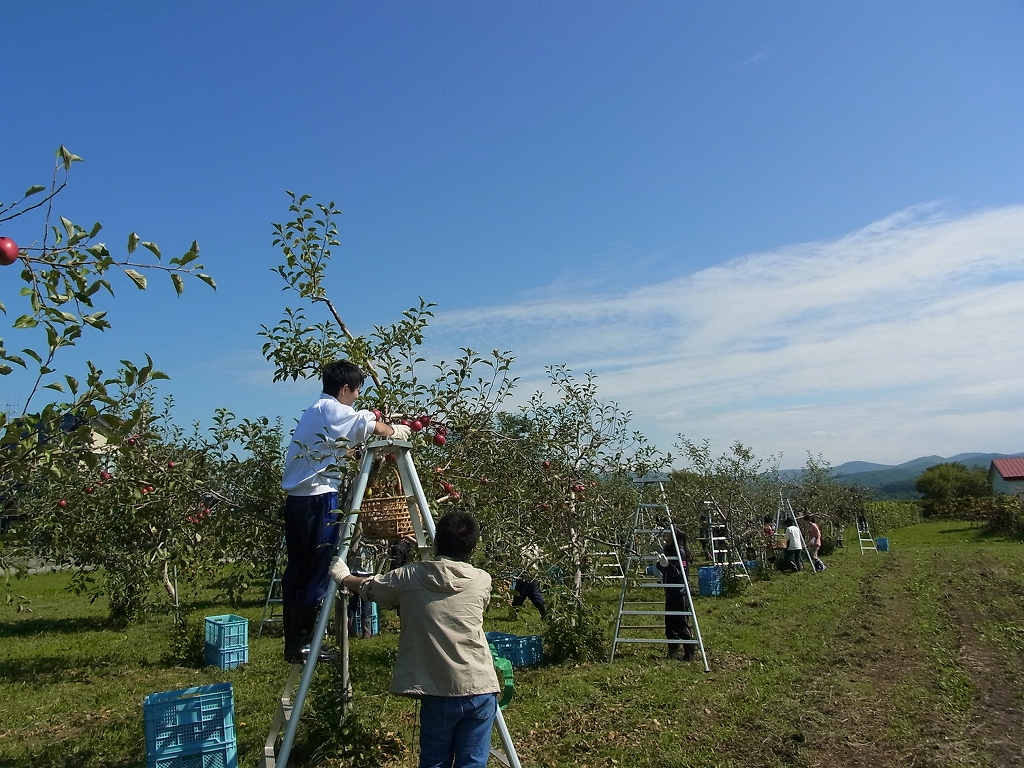
The “Field Learning Program” carried out at Yoichi Orchard (Photo courtesy of Hokkaido University Field Science Center for Northern Biosphere)

The “Field Learning Program” carried out at Yoichi Orchard (Photo courtesy of Hokkaido University Field Science Center for Northern Biosphere)
“An apple has no commercial value without this twig. We handle apples with care so those twigs aren’t broken during harvest,” as Mr. Ikuta Minoru, Senior Technical Specialist, taught us. The tiny twig is drawn in a picture of an apple. We never knew this was so important.
Yoichi Orchard covers 5.7-hectares. It is managed and operated by three people- Mr. Masushige, Senior Technical Specialist, Mr. Arakawa, a part-time staff member, and Mr. Ikuta. 21 varieties of apples are currently grown in the Orchard. Since harvest time is different for each variety, the season lasts from the middle of August to the beginning of November.

 “This tiny twig is valuable to an apple,” Mr. Ikuta, Senior Technical Specialist remarks.
“This tiny twig is valuable to an apple,” Mr. Ikuta, Senior Technical Specialist remarks.
“The purpose of our Orchard is research. We provide fruit trees and an environment which can be used for research activities and to practice teaching within the University as well as outside.”
Hoshino Yoichiro, Assistant Professor at Hokkaido University guided us through the Orchard. In addition to apples, the Orchard grows pears, grapes, honeyberries, and blueberries.
One role of the Orchard is to provide a liberal arts education. The word means general knowledge. The curriculum of “Field Learning Program,” was created from the teachings of Dr. W. S. Clark, “Learn from Nature,” and is a unique education by Hokkaido University, with Yoichi Orchard as its field. Not only members from the Faculty of Agriculture but also many other students visit the Orchard and to experience harvesting and maintenance work.
How did Yoichi Town become a “town of fruit trees?”
Fruit trees were recognized as one of the Hokkaido development projects, and the Meiji Government distributed apple seedlings imported from the United States and Canada to every corner of Hokkaido, free of charge. The former feudal retainers of the Aizu Domain are said to have greatly influenced Yoichi to be prominent among these places. The feudal retainers of the Aizu Domain who settled in Yoichi during the Meiji Restoration grew apples and the fine tasting apples gained a good reputation. The HI-NO-KOROMO variety was created here and became so famous it was presented to the Imperial Place. As a result, the name of Yoichi became widely known.

A sign from Yoichi Orchard with the name “HI-NO-KOROMO” written. (Yoichi Fisheries Museum Archives)
Insect pest control, pruning methods, soil management, etc., have been studied at Yoichi Orchard and the accumulated techniques are shared and spread among the growers in Hokkaido. While facing Hokkaido’s harsh environment, the Orchard has contributed to preparing the groundwork for the fruit-growing district.
Hokkaido University established “Field Science Center for Northern Biosphere” as a Common Use Institute in 2001. Yoichi Orchard is affiliated with the Experiment Farm of the Center. In addition, a partnership agreement on agricultural technology research was concluded between Yoichi Town and Hokkaido University in 2009.
Along with the times, changes have been taking place in Yoichi. With the establishment of the first Wine Special Zone in Hokkaido, the number of wineries and vineyards have increased. At the request of the Town, Yoichi Orchard cooperates with the University and wineries to test grape cultivation and has begun to carry out experiments in the mechanization of grape harvesting.

On the other hand, a major challenge to the growers is their age, but growing small fruit trees at Yoichi Orchard is a measure against aging.
“I think small fruit trees that require relatively less time and labor to take care of will become a secondary crop to help growers’ management. We are improving the varieties of fruit trees which can be adapted to Hokkaido and are easy to grow, and hold field seminars where growers can see the actual fruit,” said Mr. Hoshino, Assistant Professor, specializing in small fruit.
“Since fruit trees take time to mature before bearing fruit, our research, growing tests, and new growing techniques can be put into practice without risk to the growers. Contributing to the growth of regional industries is also an essential role of the Orchard of the University.”

“We can also enjoy the autumn leaves of blueberries,” Mr. Hoshino (on the left), Assistant Professor talking with Mr. Ikuta.
Hokkaido University, Field Science Center for Northern Biosphere, Yoichi Orchard
448 Yamada-cho, Yoichi Town, Yoichi-gun, Hokkaido
Tel.: 0135-22-3287
Website